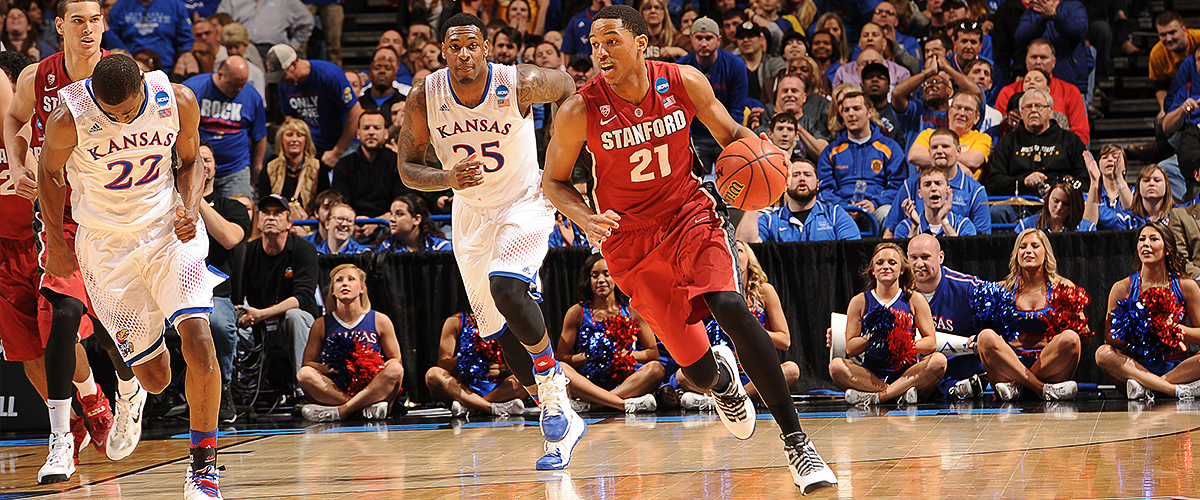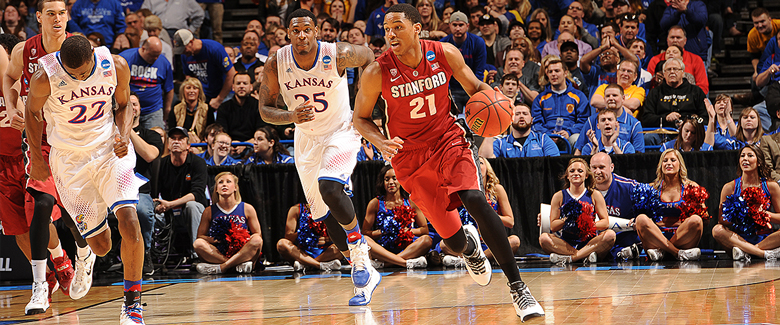As a youngster growing up in Fountain Valley, Calif., he always hoped to play in the NBA. Sure, the skinny kid was a longshot, but even then, he knew what he wanted and wasn’t afraid to put in the work. A basketball junkie, Brown spent countless hours shooting on his home basket in the driveway and dribbling in the house, trying to emulate his favorite player: Kobe Bryant.
“I never thought I’d be so tired of hearing someone dribbling,” said his mother, Raquel. “I tried to be patient, but it was definitely annoying.”
Now, Brown and Bryant are teammates.
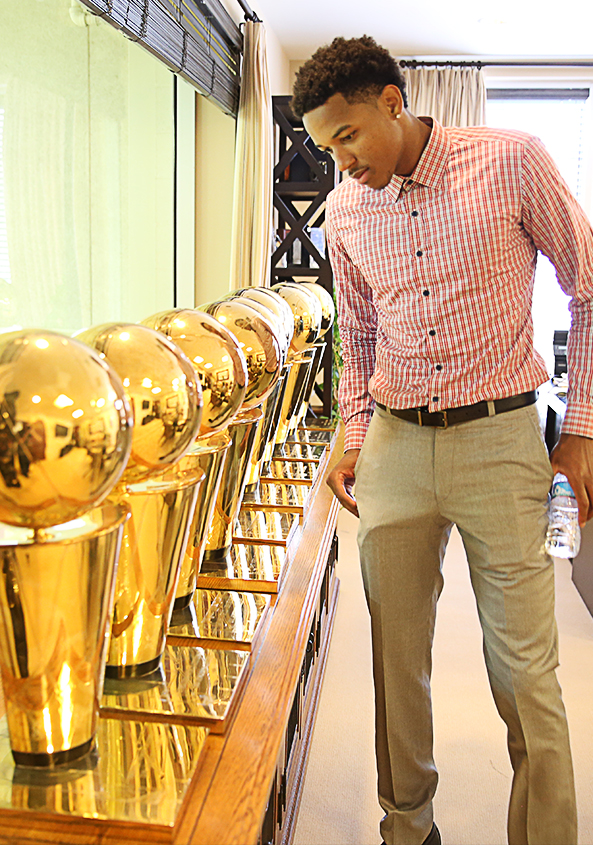
Brown grew up idolizing Kobe Bryant & the Lakers
Last month, Brown was a second-round pick and the 34th overall player selected in the NBA Draft by the Los Angeles Lakers. The springy 6-foot-7, 215-pound small forward/guard has already made a good impression in Summer League competition, which is no surprise to his college coach, Johnny Dawkins of Stanford.
“He’ll typically make the right play and doesn’t force many,” said Dawkins, the Anne & Tony Joseph Director of Men’s Basketball. “He has a good feel for the game that way. And he’s going to defend and rebound. He had more than 1,500 points and almost 700 rebounds during his career here. To have that many rebounds in college basketball at that size means he’s willing to stick his nose in there and go dig out balls in traffic. That’s a quality that I think sometimes gets overlooked that will translate at the next level.”
Brown is prominent on Stanford’s career-list of men’s basketball accomplishments. He ranks 11th in scoring (1,562 points), 14th in rebounds (691), fifth in three-point field goals made (218), tied for 13th in three-point field goal percentage (.403), tied for first with former teammate Chasson Randle in games played (144), second in minutes played (4,200) and eighth in starts (106).
This, despite undergoing two hip surgeries for a congenital ailment and redshirting his junior year.
“Coming into college, I didn’t expect to be here five years,” Brown said. “But looking back at it, it was a very rewarding experience for me being able to play in the Pac-12 and get a great education. Being able to play for a coach that played in the NBA, who learned under probably the greatest college coach of all-time (Mike Krzyzewski), was definitely a blessing for me. I wouldn’t change it for anything.”
Brown credits Dawkins for helping him overcome the injuries.
“He said, ‘Keep working. We still believe in your abilities,’ ’’ said Brown. “He was always encouraging me.”
Brown enrolled at Stanford as a 17-year-old freshman and made the Pac-10 All-Freshmen Team in 2010-11, averaging 8.7 points and 3.2 rebounds, appearing in 30 games and making 12 starts. As a sophomore, he averaged 8.1 points and 4.0 rebounds and drilled 42 three-pointers, third-best on the team. Four games into his junior season, he was sidelined with the hip injury.
“I never really had any doubts; it was more uncertainty,” he said of his comeback. “The biggest thing is will I be able to get back to 100 percent? And if I do, is it something that is going to be nagging me for the rest of my career? Luckily, I was able to fully recover.”
Dawkins said good fortune was only part of the equation.
“He (Coach Dawkins) said, ‘Keep working. We still believe in your abilities. He was always encouraging me.”
» Anthony Brown
Brown’s resiliency and toughness were not lost on his teammates.
“It was inspirational to everybody,” said junior guard Marcus Allen. “When Malcolm (Allen’s twin brother) injured his wrist last year and had to redshirt, Anthony was always in his ear giving him tips and advice to stay engaged and ready with your body and conditioning. It helped Malcolm a lot.”
Brown returned in 2013-14 to start 35 of 36 games and averaged 12.3 points and 5.0 rebounds. His 53 treys were second-most on the team and he scored in double-digits 25 times, pouring in a career-high 30 points against Washington State and 24 against Oregon. Brown was named the Pac-12’s Most Improved Player of the Year.
Former Cardinal All-American forward Josh Childress (2001-04) has also played a role. Although 10 years older, he also grew up in Southern California, played on the same AAU team, and they have many mutual friends.
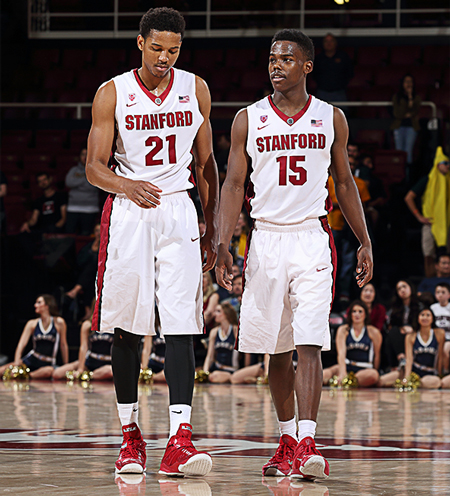
Anthony Brown & Marcus Allen
“I’m not a rah-rah kind of person,” Childress said. “I saw a bit of me in him and just wanted him to know that he had somebody he could speak to and bounce things off of. After games, I would text him and ask how he felt the game went, how he felt the coverage was, all of the technical things.
“One of the things I wanted him to understand is what it took to get to the next level. I know he had some injury issues, so that messes with your thought process and confidence. It was really about just staying positive and becoming the player he wanted to be.”
In 2004, Childress was selected the Pac-10 Player of the Year and was the sixth overall pick of the NBA Draft by the Atlanta Hawks, the highest any Stanford player has ever been chosen. He has played 10 years in professional basketball – including four NBA teams – and is now competing for the Sydney Kings of the Australian National Basketball League.
“I’ve seen the good, the bad and the ugly,” said Childress. “Not through my own career, but those next to me. So any advice I could give him, I would, from financial advisors all the way to agents. Just help him through the process.”
As a fifth-year senior, Brown started 36 of 37 games and averaged 14.8 points and a team-high 6.9 rebounds. An All-Pac-12 Honorable Mention pick, the smooth-shooting Brown averaged 43.1 percent from the field and 44.1 beyond the arc, and ranked second on the squad in assists with 94.
Brown scored 25 points at No. 9/9 Texas in an overtime win and 21 against UCLA and Arizona State. He also helped the Cardinal capture its second NIT title in four years.
“If you look at his numbers from year to year, he improved each year. That’s not by accident. He was willing to pay the price and work hard. He wanted it and fought through a lot of adversity. He was always fine with whatever it took to get better.”
» Johnny Dawkins
Dawkins always assigned Brown to guard the opposing team’s best perimeter player.
“We groomed him for that role, but you never know how a young man is going to take that,” he said. “Is he going to step up to that challenge? Or is he going to do it reluctantly because his coach told him to. There was not one game that he ever looked like, ‘Well, why doesn’t somebody else guard this guy?’ There was not one night where he didn’t study up or watch tape on that player he going to defend and really just understood everything about that player.
“A lot of guys would just grab the short version of the clips and watch them. He always wanted the extended version and wanted to know the player inside and out. I always respected him for that. I’ve seen a lot of basketball during my time and that’s the one percentile of player that is willing to do that and go the extra mile to make sure he was as prepared as he needed to be defensively.”
Brown relished his role.
“When I came back from injury, I was looking at the pieces we had and saying to myself, ‘How can I make an impact?’ ’’ said Brown. “We already had people that had played the previous year and I want to fit in. I knew if I could be a defensive stopper for us, I could really help us and accepted the challenge. My dad was a Division I player and a high school coach, so any time I could watch some film or any type of basketball, I’m always open to it. I never want to go into a game not knowing what my opposing offensive player is going to do. I don’t like to be scored on and I don’t want to be the guy that gives up 30 to the other team’s best player.”
Several basketball memories stand out at The Farm.
Brown scored 10 points and pulled down five rebounds as Stanford upset Kansas in the third round of the 2014 NCAA Tournament
“The biggest was two years ago against Kansas to reach the Sweet 16,” he said. “It was the first time I went to the NCAA Tournament and nobody believed we could win that game. My sophomore and senior year we won the NIT. Other than that, individual games are nice, but I more so remember the big team wins and celebrations in the locker room.”
Also the tightness with his teammates.
“We were really close,” said Brown. “The class that I came in with had six people, so we were all new, hung out and made the same mistakes together. I loved hanging out with those guys and still keep in touch with them.”
Brown grew up a Lakers fan, watching nearly every game on television, but never attended a game.
“Obviously, the Lakers were elite, so the ticket prices were a little bit too much,” he said. “Any chance I had to watch Kobe, I always watched.”
Brown’s father, Quentin, also 6-7, played at UC Irvine and coached high school basketball for 10 years. Brown often tagged along to practices and games.
“He was always in the huddle, listening to plays,” said Raquel, a leadership advisor. “He started watching Lakers games at age two and read a lot of basketball magazines. We thought he might end up being a commentator because he was such a student of the game. He knew every stat on everything.”
When he wasn’t shooting hoops at the local park or hanging out with his father, Brown was usually in the driveway, working on his shot until dark.
“Everyone knew he was the kid in the neighborhood who was obsessed with basketball,” Raquel said. “From the postman to the FedEx driver. They would shoot with him and play H-O-R-S-E and got big kick out of it. The FedEx driver came by on draft night and said, ‘Well, I beat a Laker.’ ’’
Brown and his father regularly played fierce one-on-one games in the driveway. He finally beat him when he was 16.
Brown wore Kobe and Carmelo Anthony jerseys, the latter because it had his first name on the back. As a junior at Ocean View High School in Huntington Beach, Calif., Brown was named CIF Southern Section Player of the Year (his father was the 1977 CIF Central Valley Player of the Year) and all-state. One of the top-rated small forwards in the country, he made no secret about wanting to play for coach Tubby Smith at Kentucky, but changed his mind when Smith went to Minnesota.
Brown decided Stanford was a better fit and was determined to help change the culture of the program.
“He had opportunities to go to bigger, more established programs,” said Raquel. “But he and his class wanted to create something. Coach Dawkins had been where they wanted to be.”
Brown has never regretted the decision. He has already completed his degree in communication and is working on a Master’s in media studies, which he hopes to complete next summer.
“It’s a competitive environment on and off the court,” said Brown. “Everybody comes out of high school and they’re the smartest student and they’re the best at whatever sport they’re in. It is humbling, because the person sitting next to you is doing just as well or better than you in school, and every athlete, if they’re not an Olympian, they’re an All-American or have all these accolades. You want to be in the upper echelon as well.”
As for playing in the NBA, Brown never stopped believing.
“Once I turned 14 or 15 and got some offers from college, I knew I might have a chance,” he said. “It was never something that I didn’t think was possible. All I needed was an opportunity.”
Now the dream has become a reality.
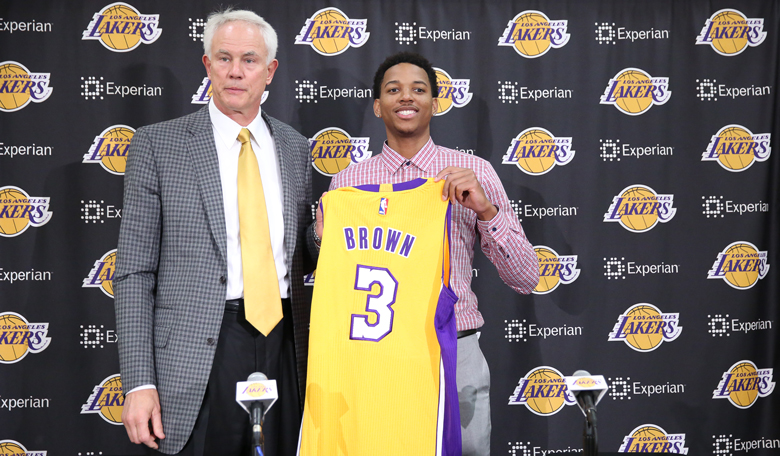
Anthony Brown & Lakers GM Mitch Kupchak
“If everything goes according to plan, the Lakers will make the playoffs,” said Brown. “I don’t have too many individual goals at this point. Just to be able to know my role and have an impact any way I can, whether that’s five minutes or 25 minutes. Just knowing that I’m getting better every day in practice. Being able to step into an NBA game and get some time would be great for me.”
Dawkins has no doubt it will happen.
“It was fun watching him develop,” he said. “He went through the normal maturation process of any young kid here, where all of a sudden you’re no longer the best player on the team or best student on campus. You have to really make adjustments and grow.
“He was willing to do that. He was willing to get outside his comfort zone and grow as a person and a player. It was fun to watch, to be quite frank. That’s one of the things in this profession that kind of goes unsaid that as mentors and coaches we see a kid’s light bulb go on and they start to figure it out at another level. He always had a goal in mind that he wanted to achieve, and then he had an opportunity to achieve it. I’m proud of any young man that does that, that sets his sights on something so lofty. He has a chance to accomplish that now.”
